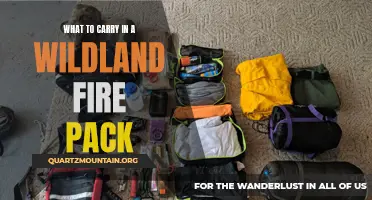
Are you planning an overnight backpacking adventure but not sure what essential items to pack? Whether you are a beginner or a seasoned backpacker, it's crucial to have the right gear for a successful and enjoyable trip. From a reliable tent to a comfortable sleeping bag and everything in between, the essential items for an overnight backpacking adventure are vital for your safety, comfort, and overall experience in the great outdoors. So grab your backpack, lace up your boots, and let's dive into the must-have essentials for your next backpacking escapade.
| Characteristics | Values |
|---|---|
| Backpack size | 40-60 liters |
| Weight | 20-30 pounds |
| Tent | Lightweight |
| Sleeping bag | Compact and warm |
| Sleeping pad | Lightweight |
| Water filter | Portable |
| Stove and cookware | Lightweight |
| Food | Lightweight and non-perishable |
| Clothing | Layered and lightweight |
| Navigation | Map and compass |
| First aid kit | Essential supplies |
| Headlamp | Lightweight and long-lasting battery |
| Personal hygiene items | Compact and biodegradable |
| Extra batteries | Backup power |
| Trekking poles | Lightweight and adjustable |
| Pocket knife | Versatile and durable |
| Fire starter | Windproof |
| Multi-tool | Compact and versatile |
| Extra rope | Lightweight and strong |
| Emergency shelter | Lightweight and easy to set up |
What You'll Learn
- What essential items should be packed for an overnight backpacking trip?
- How should clothing be chosen and packed for an overnight backpacking trip?
- What kind of food and cooking supplies should be packed for an overnight backpacking trip?
- Are there any specific safety items or gear that should be included in a backpack for an overnight trip?
- Can you provide a checklist of items to help ensure nothing important is forgotten when packing for an overnight backpacking trip?

What essential items should be packed for an overnight backpacking trip?

When planning an overnight backpacking trip, it is crucial to pack the right essentials to ensure a safe and comfortable experience. This article will guide you through the must-have items to pack for an overnight backpacking trip.
- Backpack: Start with a sturdy and comfortable backpack that fits your body perfectly. Look for one with adjustable straps, a padded waist belt, and multiple compartments for easy organization.
- Tent: A lightweight and compact tent is essential for camping overnight. Look for one that is easy to set up and provides adequate protection from the elements. Consider the number of people sharing the tent and choose the size accordingly.
- Sleeping bag: Choose a sleeping bag that is suitable for the expected weather conditions. Look for one that is lightweight, compact, and provides enough insulation for a comfortable night's sleep. Some sleeping bags even come with built-in sleeping pads for added comfort.
- Food and water: Pack enough food and water for your trip. Opt for lightweight and calorie-dense meals like dehydrated food or energy bars. Carry a water filter or purification tablets to ensure a safe water source along the way.
- Cooking gear: If you plan on cooking your meals, pack a lightweight stove, fuel, and a set of cookware. Choose a stove that is suitable for backpacking and easy to use. Don't forget to pack utensils and a water bottle for cooking and drinking.
- Clothing: Pack appropriate clothing for the expected weather conditions. Layering is key to staying comfortable in varying temperatures. Include items like a waterproof jacket, insulated layers, quick-drying pants, and moisture-wicking shirts. Don't forget to pack extra socks and a hat.
- Navigation tools: Carry a map, compass, and a reliable GPS device to help you navigate the trails. Familiarize yourself with the route and carry a guidebook or trail information for reference.
- Lighting: A headlamp or flashlight is crucial for navigating in the dark. Make sure to carry extra batteries or a rechargeable power bank to keep your light source functioning.
- First aid kit: Prepare a first aid kit with essential items like bandages, antiseptic wipes, pain relievers, and any necessary prescription medication. Familiarize yourself with basic first aid procedures before your trip.
- Personal hygiene items: Pack travel-sized toiletries including biodegradable soap, toothbrush, toothpaste, and toilet paper. Carry a small towel or wet wipes for quick clean-ups.
- Emergency and survival gear: Prepare a whistle, fire starter, multi-tool, and emergency blanket in case of unexpected situations. Knowledge of basic survival skills such as building a shelter and starting a fire is also recommended.
- Extra supplies: Pack extra batteries, a repair kit for your gear, and a lightweight tarp for extra shelter if needed. Don't forget to bring cash, identification, and any necessary permits.
Remember, the weight of your backpack is important, so try to pack only what is necessary. Prioritize items based on safety and comfort, and leave behind non-essential items. Preparation and planning are key to a successful overnight backpacking trip. Happy trails!
Essential Items to Pack for a Trip to NYC in February
You may want to see also

How should clothing be chosen and packed for an overnight backpacking trip?

When planning for an overnight backpacking trip, it is essential to choose and pack your clothing appropriately. The right clothing can provide comfort, protection, and help regulate body temperature during your adventure. In this article, we will discuss the steps to follow when selecting and packing clothing for an overnight backpacking trip, using scientific and experiential knowledge, as well as providing examples along the way.
Check the weather forecast: Before you start packing, it is crucial to know the weather conditions you will be facing during your trip. The forecast will give you an idea of the temperatures, precipitation, and wind conditions. Based on this information, you can choose appropriate clothing for each situation.
For example, if the forecast indicates warm weather with no chance of rain, you may opt for lightweight and breathable clothing such as quick-drying shorts, t-shirts, and a hat to protect yourself from the sun. On the other hand, if rain is expected, pack a waterproof jacket and pants to stay dry throughout the journey.
Layering system: Layering is a fundamental concept when it comes to outdoor clothing. It involves wearing multiple layers to provide versatility and adaptability to changing weather conditions. The layering system consists of base layers, insulation layers, and outer layers.
Base layers: These are worn next to the skin and help regulate body temperature by wicking away moisture. Choose base layers made of moisture-wicking materials like merino wool or synthetic fabrics. Examples include lightweight long-sleeve shirts and long underwear.
Insulation layers: These layers trap air and provide warmth. Fleece jackets, down vests, and synthetic insulation jackets are excellent choices for insulation layers. Depending on the weather, you can add or remove these layers as needed.
Outer layers: These layers protect you from the elements such as wind, rain, and snow. A waterproof and breathable jacket and pants are essential for the outer layer. Look for materials like Gore-Tex or eVent, which provide excellent water resistance while allowing moisture to escape.
Consider the terrain and activity level: The clothing you choose should be suitable for the terrain and activity level of your backpacking trip. If you will be hiking in rugged terrain or climbing steep slopes, opt for durable and abrasion-resistant clothing to withstand the demands of the environment.
Choose fabrics that offer stretch and mobility, allowing you to move freely. Reinforced knees and seat areas in pants are beneficial for activities involving a lot of sitting or kneeling. Additionally, consider the breathability of the fabrics, as you may sweat during intense physical exertion.
Take into account weight and packability: When backpacking, every ounce counts. Choose clothing that is lightweight and compressible, allowing you to save space and carry less weight. Look for materials that are specifically designed for backpacking, such as lightweight nylon or polyester.
Avoid cotton clothing as it retains moisture and takes a long time to dry. Synthetic or merino wool materials are better options as they dry quickly and offer insulation even when wet. Additionally, consider the size of your backpack and packability of your clothing. Roll or compress your clothing to maximize space and minimize wrinkles.
Don't forget about accessories: Accessories can make a significant difference in your comfort during a backpacking trip. Consider bringing items such as a hat, gloves, buff, sunglasses, and a neck gaiter. These accessories can protect you from the sun, wind, cold, and insects.
For example, a buff can be worn as a hat, neck warmer, or face mask. Sunglasses with UV protection are essential for eye safety in bright conditions. Gloves can keep your hands warm, and a hat can provide shade or warmth, depending on the situation.
In conclusion, choosing and packing clothing for an overnight backpacking trip requires careful consideration of the weather forecast, layering system, activity level, weight, and packability. By following these steps and considering the examples provided, you can ensure that you have the right clothing to keep you comfortable and protected throughout your adventure. Remember to always pack for the expected conditions and be prepared for unexpected changes in the weather.
Essential Items to Pack in Your Summit Pack for a Successful Outdoor Adventure
You may want to see also

What kind of food and cooking supplies should be packed for an overnight backpacking trip?

When embarking on an overnight backpacking trip, it is important to pack the right kind of food and cooking supplies to ensure a successful and enjoyable journey. This article will provide guidance on what to pack, taking into consideration scientific knowledge, personal experience, step-by-step instructions, and practical examples.
Food:
- Caloric Density: When selecting food items, prioritize those with a high caloric density. Backpacking requires substantial energy expenditure, so it is crucial to consume nutrient-dense foods. Examples include nuts, dried fruits, energy bars, and freeze-dried meals.
- Balanced Nutrition: Aim for a balanced mix of macronutrients, including carbohydrates, protein, and fats. Carbohydrates provide immediate energy, protein aids in muscle repair, and fats offer sustained energy. For instance, pack whole-grain crackers, jerky, and trail mix to cover these essential nutrients.
- Lightweight Options: Weight is a crucial factor while backpacking. Opt for dehydrated meals, which are lightweight and easy to prepare. These meals only require boiling water, making them ideal for minimal cooking time and fuel consumption.
- Fresh Foods: Don't forget to pack fresh fruits and vegetables that can withstand the trip's duration, such as apples, carrots, and oranges. These items provide essential vitamins and help break the monotony of dehydrated meals.
Cooking Supplies:
- Lightweight Stove: Choose a lightweight stove that can easily fit in your backpack. Options like compact gas stoves or alcohol burners are popular choices among backpackers due to their efficiency and portability.
- Cookware: Consider lightweight and compact cookware sets specifically designed for backpacking. These sets often include a pot, a pan, and utensils. Opt for non-stick cookware to minimize cleanup effort.
- Fuel: Make sure to bring an adequate amount of fuel for your stove, considering the number of meals you plan to cook. If using a portable gas stove, check the compatibility with the fuel canister and bring a backup as needed.
- Water Filtration: Depending on the destination, it might be necessary to bring a water filtration system to ensure access to safe drinking water during the trip. Portable filter systems or water treatment tablets are excellent options to consider.
- Utensils and Accessories: Don't forget to pack utensils like a spork (combination spoon and fork) and a pocket knife. Additionally, consider bringing a lightweight cutting board, a collapsible water container, and a fire starter for emergencies.
Practical Examples:
- Breakfast: Pack oatmeal, powdered milk, and granola in separate ziplock bags. In the morning, boil water and add it to the oatmeal mixture. Top it with dried fruits and nuts for added flavor and nutrition.
- Lunch: Prepare tortilla wraps with dehydrated hummus, pre-cooked bacon, and cheese. These ingredients pack well and provide a satisfying meal during the hike.
- Dinner: Consider pre-packaged freeze-dried meals that only require boiling water. These meals often include a mix of protein, carbohydrates, and fats, providing a complete meal after a long day on the trail.
- Snacks: Bring a mix of energy bars, dried fruits, nuts, and chocolate to keep your energy levels up throughout the day. These lightweight snacks provide quick bursts of energy.
In conclusion, when planning and packing for an overnight backpacking trip, consider the scientific knowledge, personal experience, step-by-step instructions, and practical examples shared in this article. By selecting high-caloric density foods, packing the right cooking supplies, and following these examples, you will be well-prepared to fuel your adventure and enjoy the outdoors to the fullest.
Essential Items to Pack for an Unforgettable Backroads Trip
You may want to see also

Are there any specific safety items or gear that should be included in a backpack for an overnight trip?

When preparing for an overnight trip, it is important to prioritize safety and be prepared for any situation that may arise. This includes ensuring that your backpack is equipped with the necessary safety items and gear. Here are some specific items that should be included in a backpack for an overnight trip:
- First Aid Kit: One of the most important safety items to have in your backpack is a well-stocked first aid kit. This should include band-aids, sterile gauze pads, adhesive tape, antiseptic wipes, scissors, tweezers, and any necessary medications. It is also worth considering including a basic first aid manual and a list of emergency numbers.
- Navigation Tools: Depending on the type of overnight trip you are going on, it may be necessary to include navigation tools such as a map, compass, and GPS device. These tools will help you navigate your way if you happen to get lost or need to reroute. Make sure you are familiar with how to use these tools before setting out on your trip.
- Personal Locator Beacon (PLB): For outdoor adventurers who are going off the beaten path, a personal locator beacon can be a lifesaver. These devices emit a distress signal that can alert search and rescue teams to your location in case of an emergency. PLBs are small, lightweight, and should be kept accessible in your backpack.
- Emergency Shelter: In the event of unforeseen circumstances such as extreme weather or injury, having an emergency shelter in your backpack can provide protection and comfort. Options include lightweight tents, bivvy bags, or even a large tarp. Choose a shelter that is compact, easy to set up, and provides adequate protection from the elements.
- Fire Starter Kit: Fire can provide warmth, light, and a means to cook food in an emergency situation. It is essential to have a fire starter kit in your backpack, which should include waterproof matches, a lighter, and some fire starter material such as cotton balls soaked in petroleum jelly. Practice fire-starting techniques before your trip to ensure you know how to use your kit effectively.
- Headlamp/Flashlight: Carrying a reliable source of light, such as a headlamp or a flashlight, is crucial for any overnight trip. Even if you don't plan on being out after dark, unexpected circumstances such as delays or emergencies may require illumination. Choose a lightweight, durable light source and bring extra batteries to ensure you won't be left in the dark.
- Multi-tool: A multi-tool is a versatile item that can come in handy in a variety of situations. It typically includes a knife, scissors, screwdrivers, and other useful tools. Having a compact multi-tool in your backpack will allow you to perform basic repairs, open packages, and handle unexpected tasks that may arise during your trip.
- Emergency Food and Water: While you should already have food and water packed for your overnight trip, it is also important to include emergency rations in case of unexpected circumstances. These could include energy bars, trail mix, or freeze-dried meals that are lightweight and have a long shelf life. Additionally, packing a water filter or purification tablets will allow you to safely drink water from natural sources if needed.
Remember, these are just some of the safety items and gear that should be included in a backpack for an overnight trip. The specific items you choose may vary depending on the type of trip, the duration, and the location. It is always a good idea to assess the potential risks and plan accordingly to ensure a safe and enjoyable adventure.
Essential Items to Pack for a Memorable Legoland Trip
You may want to see also

Can you provide a checklist of items to help ensure nothing important is forgotten when packing for an overnight backpacking trip?

When embarking on an overnight backpacking trip, it is important to pack all the necessary items to ensure a safe and enjoyable experience. Forgetting something crucial can not only be inconvenient but also pose a potential risk to your well-being in the wilderness. To help you stay organized and prevent any important items from being left behind, here is a checklist to follow when packing for an overnight backpacking trip.
- Navigation tools: Bring a compass, paper map, and a GPS device (if available) to help you navigate through the wilderness. Make sure you are familiar with using these tools before heading out.
- Shelter: Unless you're planning to sleep under the stars, bring a tent or a lightweight hammock with a tarp to protect you from the elements. Check for any tears or damages before packing it.
- Sleeping bag and sleeping pad: A quality sleeping bag and sleeping pad will keep you warm and comfortable during the night. Choose a sleeping bag suitable for the weather conditions you'll be facing.
- Clothing: Pack enough clothing to keep you comfortable during the day and warm during the night. This includes moisture-wicking base layers, insulating layers, a waterproof jacket, extra socks, and a hat. Don't forget to pack a pair of sturdy hiking boots or shoes.
- Food and water: Bring enough food to sustain you throughout the trip. Opt for lightweight, high-energy options such as dehydrated meals, trail mix, energy bars, and instant coffee or tea. Carry a water filter or purification tablets to ensure a safe water supply.
- Cooking equipment: If you plan on cooking your meals, bring a lightweight stove, a pot or pan, utensils, and a lightweight dish for eating. Don't forget to pack a lighter or matches for starting a fire.
- First aid kit: It is essential to have a well-stocked first aid kit that includes bandages, antiseptic wipes, pain relievers, blister treatment, and any personal medications you may require. Familiarize yourself with basic first aid procedures before your trip.
- Hygiene items: Essential hygiene items include toilet paper, hand sanitizer, a small towel, toothbrush, toothpaste, and any other toiletries you may need. Place all liquids in leak-proof containers.
- Lighting: Bring a headlamp or flashlight with extra batteries. This will come in handy for nighttime navigation and any emergencies that may arise.
- Miscellaneous items: Consider including a pocket knife, a repair kit for any gear that may break or rip, a light tarp for additional shelter, insect repellent, sunscreen, and a garbage bag for waste disposal.
Before you head out on your backpacking trip, make sure to check the weather forecast and adjust your packing list accordingly. It might also be helpful to practice packing and unpacking your backpack before your trip to ensure everything fits properly.
Remember, the key to a successful backpacking trip is to pack smart and only bring the essentials. By following this checklist, you will be well-prepared for your overnight adventure and minimize the risk of forgetting anything important. Happy backpacking!
Essential Items to Pack for a April Trip to Belize
You may want to see also
Frequently asked questions
When packing for overnight backpacking, it's important to bring clothing that is lightweight, versatile, and appropriate for the weather conditions. Pack a base layer made of moisture-wicking fabric to keep you dry and comfortable. Bring a mid-layer for insulation, such as a fleece or down jacket. Don't forget to pack a lightweight, waterproof outer layer to protect you from rain or wind. Pack a couple of pairs of quick-drying hiking pants or shorts, and bring enough socks and underwear for each day of your trip. Lastly, pack a hat, gloves, and a buff or bandana to protect your face from the sun or cold temperatures.
The essential gear for overnight backpacking includes a backpack, a tent, a sleeping bag, a sleeping pad, a stove, cookware, water bottles or a hydration system, a headlamp or flashlight, a multi-tool or knife, a first-aid kit, and a map and compass or GPS device. Additionally, you may want to bring trekking poles for added stability, a portable water filter for drinking water from natural sources, a bear canister if camping in bear country, and a camera to capture the beautiful scenery. It's important to consider the weight and size of your gear, as you'll be carrying it on your back for an extended period.
When planning your meals for overnight backpacking, it's important to consider the nutritional content, weight, and ease of preparation of the food. Aim for lightweight, calorie-dense options that require minimal cooking or preparation. Pack dehydrated or freeze-dried meals, energy bars or gels, nuts and dried fruits, jerky or other lightweight sources of protein, instant oatmeal or granola for breakfast, and instant coffee or tea for a warm beverage. Don't forget to bring enough water or a water filter to stay hydrated throughout your trip. Additionally, it's a good idea to pack some extra snacks in case you get hungry between meals or encounter unexpected delays.







